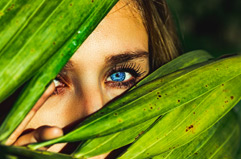
Cornea Diseases / Cornea Damage Symptoms and Treatment

The cornea is the eye’s outermost layer. It is the clear, dome-shaped surface that covers the front of the eye. It plays an important role in focusing your vision as it is responsible for transmitting light into the back of the eye.
What are the main causes of cornea problems?
Eye disease and injuries, aside from leading to potentially lengthy and expensive emergency room and / or hospital visits, can damage the cornea. Here are some common eye problems that can lead to a damaged cornea:
- Keratoconus, where the cornea is cone shaped rather than dome-shaped
- Fuchs’ dystrophy Fuchs Dystrophy is where endothelial cells in the inner layer of the cornea are not working effectively
- Photokeratitis caused by exposure to UV light.
- Eye infections or injuries that scar the cornea
- corneal abrasion corneal abrasion refers to a scratch or scrape on the cornea.
- Corneal ulcer is an open sore on the cornea.
- Pterygium is a pinkish, triangular tissue growth on the cornea.
All of these concerns can present with dry eye, blurred vision, eye pain, watery eyes, light sensitivity, and a number of other symptoms that are typical of eye injuries or corneal disease.
While severity of these symptoms may vary, it is important to understand the diseases and other eye health concerns or medical emergency issues that you could be dealing with and the treatment options that can alleviate them.
Corneal Surface Disease and Treatment
 Photo-therapeutic Keratectomy (PTK) is used to treat corneal surface diseases, damage, and scars. A special note for those who wear glasses or contact lenses, PTK is not used to reduce dependency on glasses or contact lenses but rather to produce a smoother, clearer cornea. You may still need your contact lenses or glasses after this procedure.
Photo-therapeutic Keratectomy (PTK) is used to treat corneal surface diseases, damage, and scars. A special note for those who wear glasses or contact lenses, PTK is not used to reduce dependency on glasses or contact lenses but rather to produce a smoother, clearer cornea. You may still need your contact lenses or glasses after this procedure.
Corneal Transplant Procedures

Corneal Transplant overview
If your cornea cannot be healed or repaired, your ophthalmologist may recommend a corneal transplant. This is when the diseased cornea is replaced with a clear, healthy one from a human donor.
Penetrating Keratoplasty
Penetrating keratoplasty (PK) or full thickness cornea transplant replaces the entire cornea with a clear donor cornea. Getting complete vision back after PK may take up to 1 year or longer.
With a PK, there is a slightly higher risk than with other types of corneal transplants that the cornea will be rejected. This is when the body’s immune system attacks the new tissue.
Deep Anterior Lamellar Keratoplasty (DALK)
Partial thickness corneal transplant (deep anterior lamellar keratoplasty, DALK) replaces the front and middle layers of the cornea while keeping the endothelial layer, or thin back layer, in place.
DALK is commonly used to treat keratoconus or bulging of the cornea.
Healing time after DALK is shorter than after a full cornea transplant. There is also less risk of having the new cornea rejected.
Endothelial Keratoplasty
In some eye conditions, the innermost layer of the cornea called the “endothelium” is damaged. This causes the cornea to swell, affecting your vision.
Endothelial keratoplasty is a surgery to replace this layer of the cornea with healthy donor tissue. It is known as a partial transplant since only this inner layer of tissue is replaced.
There are a few types of endothelial keratoplasty. They are known as:
DSEK (or DSAEK) Descemet’s Stripping Automated Endothelial Keratoplasty
DMEK Descemet’s Membrane Endothelial Keratoplasty
Each type removes damaged cells from an inner layer of the cornea called Descemet’s membrane. The damaged corneal layer is removed through a small incision. Then the new tissue is put in place. Just a few stitches—if any—are needed to close the incision.
Much of the cornea is left untouched. This lowers the risk of having the new cornea cells being rejected after surgery.
Things to know about DSEK and DMEK:
DSEK (DSAEK) Descemet’s Stripping Automated Endothelial Keratoplasty
With DSEK/DSAEK surgery, the donor tissue may be easier to transplant and position because it is thicker than the donor tissue in DMEK surgery.
DMEK Descemet’s Membrane Endothelial Keratoplasty
In DMEK surgery, the donor tissue is thin and can be more difficult to transplant. However, recovery is quicker because the transplant tissue is thinner.
While no surgical procedure is without its' risk of possible complications, the Cleveland Clinic in a study recorded 99.6% graft clarity at 3-12 months for DSAEK and DMEK procedures.
Your eye doctor / surgeon will choose the type of surgery based on your cornea’s condition.
NCEENT has the answer!
Before resigning to an eye patch and eye drops as a solution to your pain or dry eye, come see the professionals at North Carolina Eye, Ear, Nose, and Throat for a proper diagnosis to make sure your discomfort is not possible cornea damage symptoms and/or a sign of a serious cornea issue.
what could seem like a simple scratched eye, blurred vision, irritation due to a contact lens, or temporary sensitivity to light could be indicative of a deeper problem. Lubricating eye drops may be the answer, but deeper intervention may be necessary.
It is important to have any eye pain, discomfort, or a scratched cornea treated right away, otherwise something as simple as exposure to ultraviolet light could exacerbate the problem, where a simple problem may require eye surgeries and long recovery times.
There are additional diseases and issues that can arise that we did not dig too deep into here (ocular herpes, corneal dystrophies, different build ups of scar tissue, corneal ulcer, and other issues that could lead to a trip to the nearest emergency room!).
North Carolina EENT has offices in Cary, Durham, Chapel Hill, Roxboro for treatment of blurry vision, dry eyes, and all the other symptoms caused by Cornea Disease.
Call Today!
.jpg)
To prevent cornea damage, always flush the yes with water if you suspect foreign bodies may have entered the eye, and always wear safety goggles when doing yard work or any other activities where small objects could enter the eye and cause corneal abrasions.
Contact us today! Make an appointment at one of our nearby offices, to discuss treatment options with an eye doctor, from eye drops to surgery, we've got you covered!
